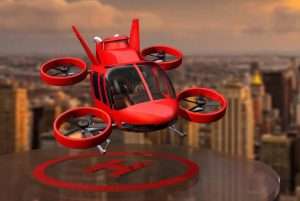
AAM or Advanced Air Mobility is described by NASA as
a safe, automated air transportation system for passengers and cargo in urban and rural. locations. Autonomous—able to control the actions of oneself; in aircraft, flying without a human controlling it.
The vision of AAM is that of a safe, accessible, automated, and affordable air transportation system for passengers and cargo capable of serving previously hard-to-reach urban and rural locations. According to recent NASA-commissioned market studies, by 2030 there will be as many as 500 million flights a year for package delivery services and 750 million flights a year for air metro services. AAM will help ensure this new airspace is properly managed. Compared to airplanes and helicopters, the aircraft that fly in this new airspace are small. This, along with where they fly, makes it unrealistic to continuously track or control these aircraft using radar or satellite technology. Many of these aircraft are Unmanned Aerial Vehicles, or UAVs, or as they are known as here in Australia RPA (Remote Piloted Aircraft) meaning they are self-flying or autonomous.
With somewhat of a futuristic glance into what tomorrow may look like, it would seem that Advanced Air Mobility may be a lot closer than most would think. When we consider it was not not that long ago the airspace user really only consisted of manned fixed wing and rotors pilots and maybe a handful of support staff or cabin crew, it really was a one parachute fits all pilots situation in regulating commercial and non commercial players in the game. In what seemed like one split nano second witnessed a whole new swath of tech and players entered the game which kind of caught CASA and other regulators around the world off guard. Some say that COVID allowed regulators some time to catch up but now that by all accounts, as regulated airspace returns to the new type of normal order, it would appear CASA has learnt from recent times that technology has the ability to bolt as quick as lightning out the gate and in the world of regulating airspace to keep people in the sky and down on the ground as safe as possible, is not something you want to be playing catch up with and if you throw into the mix a new airspace user category than you have a very large job ahead of you.
For decades there’s been a fascination with the idea of this type of travel, but it is only in recent years that this sector has gained serious momentum, like a lot of momentum. It would seem that with the likes of key giant players such as Hyundai and Honda investing heavily in the area of AAM and developing Vertiports, new propulsion systems and even the aircrafts. Efforts like this give validation to some report suggesting around 2.2 Billion dollars have been spent in the first 6 months of 2022.
"With the likes of giant players such as Hyundai and Honda investing heavily in the area of AAM and developing Vertiports"

A McKinsey and Company’s report suggest 2.2Billion flowed into the developing industry between Jan 2022 and June 2022, not bad considering nothing is up in the air running at presenrt. With the likes of giant players such as Hyundai and Honda investing heavily in the area of AAM and developing “Vertiports” the terminal name given to Advanced Air Mobility
Still don’t believe that Advanced Air Mobility is just around the corner?? Then please if I may, introduce you to the Jetson One and for the very reasonable price of $92,000USD you can own one (Well, there is currently a 2 year wait). but none the less is there real call from CASA to get a head of that curve. Which by all account appear to be well on their way with the recent release of the strategic regulatory roadmap. The RPAS and AAM roadmap sets out our long-term plan for safely integrating these technologies into Australia’s airspace and future regulatory system, alongside traditional aviation
AAM like the Jetson that sell for $92,000USD have already sold out.
If you are interested in reading the document released by CASA, the RPAS and AAM strategic regulatory roadmap you can be download from HERE.
The concept of Advanced Air Mobility is a new way of transporting people and cargo. It allows for a more efficient, safe, and convenient way to move goods and people from one location to another. Advanced Air Mobility is also known as urban air mobility or UAM. It is a type of transportation that uses an aircraft to deliver people and cargo short distances within cities.
It is hoped that Advanced Air Mobility will work by using drones that can be programmed to pick up passengers or cargo in specific locations. The drones then fly the passengers or cargo to their destination without stopping at other locations along the way. This will allow for faster travel times than traditional methods such as trains, buses, or cars would provide.
The benefits of Advanced Air Mobility would in theory include: – Safety: there are fewer accidents because there are no other vehicles on the road with you – Efficiency: it takes less time than other forms of transport – Convenience: no waiting in line at busy train stations or airports
There are many ways that Advanced Air Mobility can be used and it is hoped that the first of these key tasks would include: medical transport; disaster relief; deliveries to remote areas. I for one am very excited to see how this new tech and airspace sector develops over the next 2 years.



















